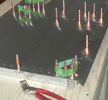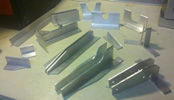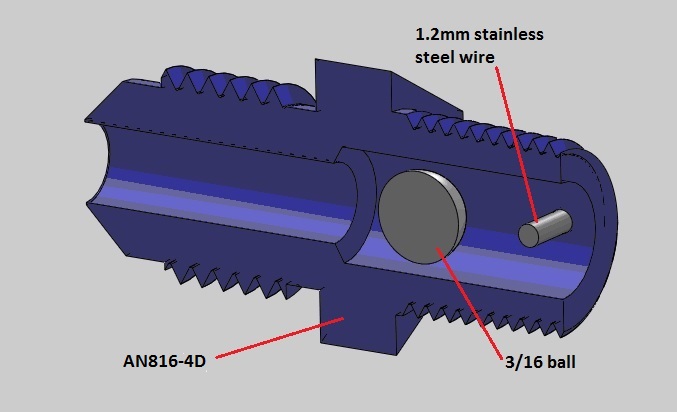


random user submitted photo
Fuel tank vent routing
25 posts
• Page 2 of 3 • 1, 2, 3
Re: Fuel tank vent routing
The plans do not show the vent like that. It goes down and vents below, no ram pressure.
Bryan Cotton
Poplar Grove, IL C77
Waiex 191 N191YX
Taildragger, Aerovee, acro ailerons
dual sticks with sport trainer controls
Prebuilt spars and machined angle kit
Year 2 flying and approaching 200 hours December 23
Poplar Grove, IL C77
Waiex 191 N191YX
Taildragger, Aerovee, acro ailerons
dual sticks with sport trainer controls
Prebuilt spars and machined angle kit
Year 2 flying and approaching 200 hours December 23
-

Bryan Cotton - Posts: 5491
- Joined: Mon Jul 01, 2013 9:54 pm
- Location: C77
Re: Fuel tank vent routing
That is how I have my vent and have never had a rough running engine due to it. The amount of pressure a small 1/4” forward facing tube can create is very minimal. The fuel sloshing out is common if it’s a taildragger and you put a full 17 gallons in the tank. You can either stop filling at 15 to 16 gallons or run it up and underneath like others do. Changing the routimg won’t keep the fuel from coming out but it will keep it contained under the plane instead of on your windscreen. I would also look hard at other places for the rough running condition. Take a close look at the fuel line routing and insulation and read up on the sonex burps. If the plane is new to you I would also suggest checking to make sure the mixture is set right and the valves are gapped correctly.
Keith
#554
Keith
#554
- kmacht
- Posts: 772
- Joined: Tue Jun 21, 2011 11:30 am
Re: Fuel tank vent routing
Arnieb wrote:I bought a Sonex that was completed but wasn't flying. I have 7 hours in the air with it, there has been a few problems that I was able to straighten out. The latest is the engine started running ruff when I was in the air so I thought I better get back on the ground. When I was coming in for the landing fuel started coming out of the fuel vent, I am wondering if the way the builder had placed the vent was correct if not is that why I built pressure in the tank. He has the vent facing forward just above the fuel door.
Fuel coming from the forward facing fuel vent is a very easy problem to solve. Fit one of these:

You can make your own if you like from an AN816-4D and a 3/16" teflon ball, or you can buy one from me http://www.ansoneng.com/sample-page/products-summary/fuel-system-parts/for the princely sum of A$15 (about US$11). For those of you that think you don't have a problem because your vent exits below the aircraft, you are wrong. The fuel still comes out the vent but you just can't see it.
Peter
- peter anson
- Posts: 558
- Joined: Thu Jul 31, 2014 2:34 am
- Location: Mount Macedon, Australia
Re: Fuel tank vent routing
To avoid spilling fuel out your vent, and in the absence of a check valve, it will have to be taller than shown in the photograph. Mine exits about 4" above the cowling and I've never lost any fuel out of it even with a full tank. While the plans may show the fuel tank vent exiting below the cowling, an early factory Sonex had the vent exiting above the fuel door and that is what some of us copied and appreciate for its simplicity (not its aesthetics).
Art,,,,,,,,,,,,,,,,,,,,,,Sonex taildragger #95,,,,,,,,,,,,,,,,,,,,,,Jabiru 3300 #261
Art,,,,,,,,,,,,,,,,,,,,,,Sonex taildragger #95,,,,,,,,,,,,,,,,,,,,,,Jabiru 3300 #261
- builderflyer
- Posts: 441
- Joined: Sat Jul 09, 2016 12:13 pm
Re: Fuel tank vent routing
In this photo you can see that my vent is easily more than 4" high. It would leak fuel on quite gentle descents if I had more than about 50 litres (13 gallons) of fuel.


- peter anson
- Posts: 558
- Joined: Thu Jul 31, 2014 2:34 am
- Location: Mount Macedon, Australia
Re: Fuel tank vent routing
peter anson wrote:In this photo you can see that my vent is easily more than 4" high. It would leak fuel on quite gentle descents if I had more than about 50 litres (13 gallons) of fuel.
Peter,
It's difficult to explain why your experience would be different than mine. Both of our vent tubes appear to be of similar height and both appear to point directly into the slipstream. I have since flared the entrance to the tube but I had flown lots of hours before doing that wIth similar results.
When you did your gentle descents, would that be with the throttle pulled back to idle? I ask because I usually run an absolute minimum of 1500 rpm in a descent (all my approaches are with power until a very short final) and even with a near full tank, there is no fuel spill.
Art,,,,,,,,,,,,,,,,,,,,,,,,Sonex taildragger #95,,,,,,,,,,,,,,,,,,,,,Jabiru 3300 #261
- builderflyer
- Posts: 441
- Joined: Sat Jul 09, 2016 12:13 pm
Re: Fuel tank vent routing
My vent comes out the top, like Peter's. And, yes, in a descent with a full tank it will spew fuel out the vent. My solution was to leave the fuel level down a couple inches (never fill the tank full). But, I have a question. If the vent is routed out the bottom, how do you check it and/or protect it from bugs clogging it?
Ron
Ron
- Arjay
- Posts: 65
- Joined: Mon Jun 30, 2014 4:04 pm
Re: Fuel tank vent routing
hi all, ron,
We origionally had a short vent tube sticking straight up , and the bent 90 degrees into the wind. We then were concerned with this set up, namely fuel getting on to the lexan, either from fuel expansion, and or flying with forces venting fuel out. We were also worried about an event if the plane ended up upside down on the ground and the fuel leaking out. We then got a steel brake line from the auto parts store , and installed this venting out the bottom. it has a 90 bend into the wind. we also drilled a small hole on the backside of the tube, up from the bend. just incase a bug would hit and clog up the front entry. peter ansons trick with the check valve is the way to go. we will install this. we may be venting out the bottom , but wouldnt see if any mist coming out.
WaiexN143NM
Michael
We origionally had a short vent tube sticking straight up , and the bent 90 degrees into the wind. We then were concerned with this set up, namely fuel getting on to the lexan, either from fuel expansion, and or flying with forces venting fuel out. We were also worried about an event if the plane ended up upside down on the ground and the fuel leaking out. We then got a steel brake line from the auto parts store , and installed this venting out the bottom. it has a 90 bend into the wind. we also drilled a small hole on the backside of the tube, up from the bend. just incase a bug would hit and clog up the front entry. peter ansons trick with the check valve is the way to go. we will install this. we may be venting out the bottom , but wouldnt see if any mist coming out.
WaiexN143NM
Michael
- WaiexN143NM
- Posts: 1206
- Joined: Mon Sep 15, 2014 1:04 am
- Location: palm springs CA
Re: Fuel tank vent routing
When you did your gentle descents, would that be with the throttle pulled back to idle? I ask because I usually run an absolute minimum of 1500 rpm in a descent (all my approaches are with power until a very short final) and even with a near full tank, there is no fuel spill.
Unless there is some danger of over-speeding or conditions are rough I leave the power on. The first time I ever noticed fuel loss I had started with a full tank and flown to an airfield about 70 NM distant , so about 35 minutes flight. I would have used at least 10 litres of fuel in that distance which is how I arrived at the 50 litres figure, but it is very likely that there was even less fuel in the tank. The only solution at the time was to reduce the rate of descent which was already fairly gentle. With a full tank the fuel loss is much worse, but you rarely do a descent with a full tank.
As Michael has pointed out, one problem with a top vent if you don't have some sort of check valve is that if the aircraft becomes inverted, a very common occurrence in forced landings, the fuel can just pour out the vent.
I do the occasional long distance flight and not filling the tank completely is not really an option for me except on short local flights. Not filling the tank would reduce the already short range to about 1 3/4 hours.
Regarding the possibility of insects clogging a fuel vent, a friend did have this happen and his Sonex was extensively damaged in the forced landing, although fortunately without injury to the pilot.
Peter
- peter anson
- Posts: 558
- Joined: Thu Jul 31, 2014 2:34 am
- Location: Mount Macedon, Australia
Re: Fuel tank vent routing
hi all, peter,
Thats an interesting story peter. Was it caused by a bug impact and clogging the vent, or bugs on the ground trying to build a nest? i would encourage anyone to also drill a smaller hole on the backside of the tube away from the bend to allow for a second source of air. this would be good for the bug impact scenario.
Fly safe!
waiexN143NM
Michael
Thats an interesting story peter. Was it caused by a bug impact and clogging the vent, or bugs on the ground trying to build a nest? i would encourage anyone to also drill a smaller hole on the backside of the tube away from the bend to allow for a second source of air. this would be good for the bug impact scenario.
Fly safe!
waiexN143NM
Michael
- WaiexN143NM
- Posts: 1206
- Joined: Mon Sep 15, 2014 1:04 am
- Location: palm springs CA
25 posts
• Page 2 of 3 • 1, 2, 3
Who is online
Users browsing this forum: No registered users and 17 guests







